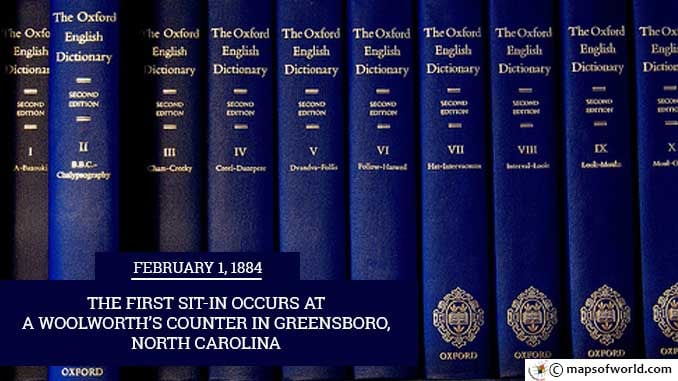On February 1, 1884, the first fascicle of Oxford English Dictionary was published. The dictionary has been the most popular and one of the most detailed English language dictionaries till date. The earliest organized English dictionary available to users was Samuel Johnson’s. This dictionary was published in 1755 and was followed by a number of English language users for over a century and half. The publication of the Oxford English Dictionary or the OED was initially planned by the Philological Society of London. In 1857, members of the Philological Society rued the lack of a competent dictionary to keep up with the changes since Anglo-Saxon times and the highlight the nuances of the English language. The Society decided to embark on a project that would produce “a dictionary worthy of the English language.” The ideal outcome of this project was described by the Society thus – “the first requirement of every lexicon is that it should contain every word occurring in the language of the literature it professes to illustrate.” In 1879, after almost two decades of preparation, the Philological Society tied up with the Oxford University Press (OUP) to compile and edit the dictionary. A Scottish schoolmaster and an enterprising philologist from London, James Murray was selected to be the editor. The dictionary was initially expected to be a four-volume publication of about 6,400 pages and would require a decade of labor. On February 1, 1884, the first fascicle of A New English Dictionary on Historical Principles (as the Oxford English Dictionary was then called) was published. The volume contained all entries starting from A till the word Ant. The entire project took 40 years to complete instead of 10 years. Holding over 400,000 words and phrases in 10 volumes, the full New English Dictionary was complete in April 1928 when the 125th and final fascicle was published. Through the course of the forty years it took to complete the dictionary there were many significant additions to the editorial team. Apart from Murray, Henry Bradley, WA Craigie, and CT Onions were the directors of the editorial team. Immediately after the 10 volume publication in 1928, Craigie and Onions, the editors who chose to remain with the project, set out on updating it and by 1933, a single-volume Supplement was published. It was then that the dictionary was given its current name – Oxford English Dictionary (OED). It also started to be printed in twelve volumes. The dictionary became the most detailed work of the sort ever undertaken and came to be known as the last word in any debate concerning English semantics. The longest word contained in the dictionary at the time was “floccinaucinihilipilification” – the action or habit that deems something as worthless. The word “set” had entries running into 18 pages, posing an editorial challenge that led Murray to declare, “the language seems not to contain a more perplexing word than set.” Murray was knighted by King Edward VII but did not live to see his work published. He died in 1915. It is believed that of the 15,487 pages in the completed OED, Murray had personally edited at least half. The second edition of the Oxford English Dictionary, referred to as the OED2, was published in 1989. The dictionary now stood at 20 volumes and contained about half a million entries. In August 2010, the Oxford University Press (OUP), the owner of this renowned dictionary, announced that the third edition of the OED, popularly referred to as the OED3, would appear only in an electronic format and would not be printed. The OED3 had a team of 80 lexicographers working on it for 21 years. The drastic decline in the print market and the immense popularity of the online OED (which generated two million hits each month and earned the publisher an annual subscription fee of about £240 for each user) led the publishers to discontinue the print version. Work on the OED3 is expected to be completed by 2020. In the meanwhile, the OUP continues to print the single-volume dictionary used popularly by students and others – the Oxford Dictionary of English. The Concise Oxford Dictionary, compiled by Henry Fowler and Frank was first published in 1911. It drew about 38,000 headwords from the OED and has since then been considered the best concise dictionary in the world. In 2011, the twelfth (centenary) edition was published as the Concise Oxford English Dictionary which now contains 66,500 headwords. You may also like : February 1 1960 – The First Sit-In Occurs at a Woolworth’s Counter in Greensboro, North Carolina
February 1 1884 – The first fascicle of the Oxford English Dictionary is published
On February 1, 1884, the first fascicle of Oxford English Dictionary was published. The dictionary has been the most popular and one of the most detailed English language dictionaries till…
